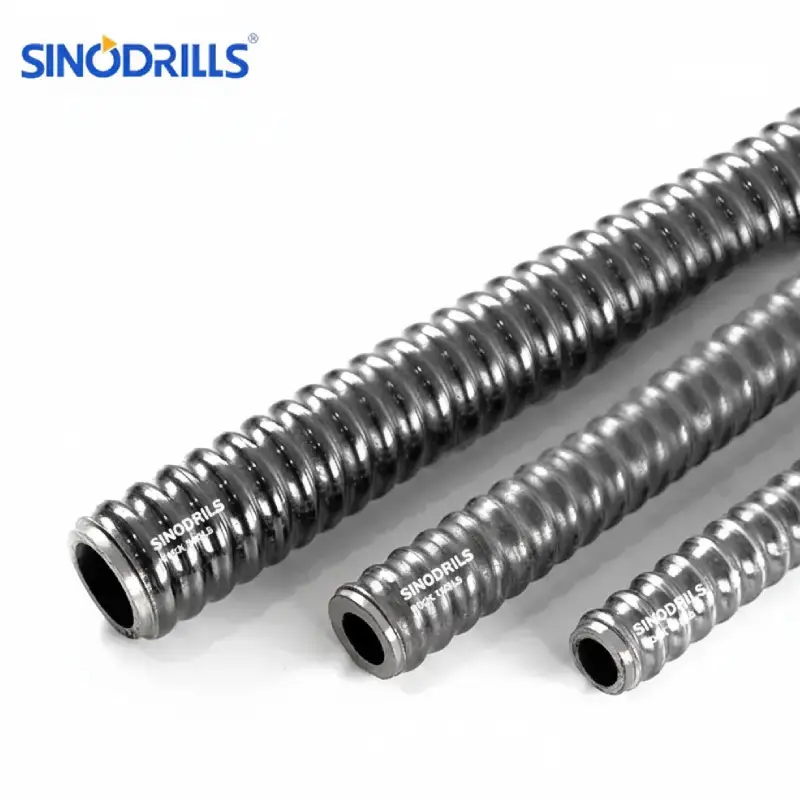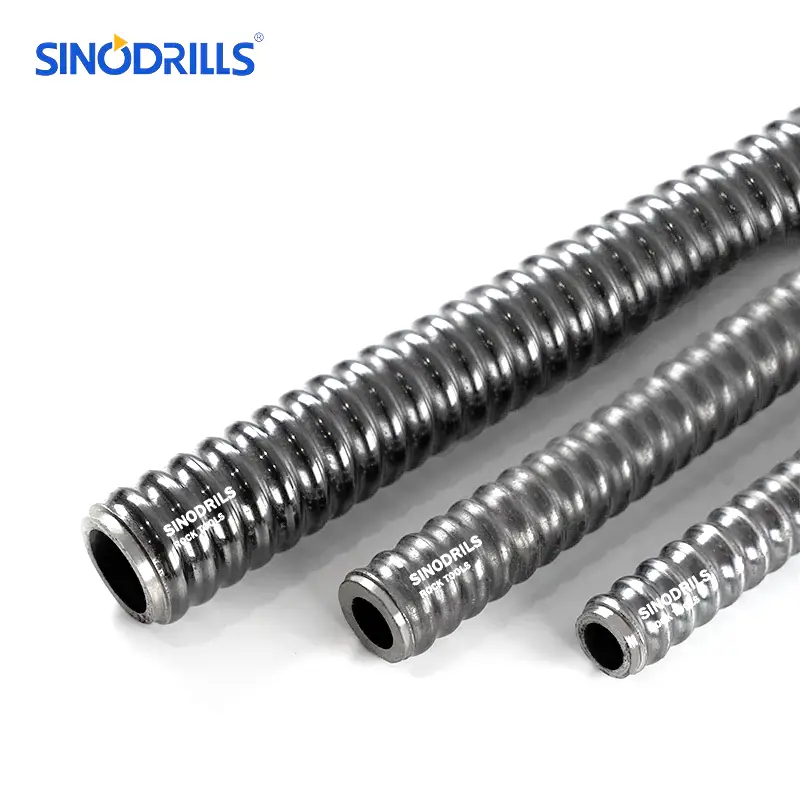What is Self Drilling Anchor System?
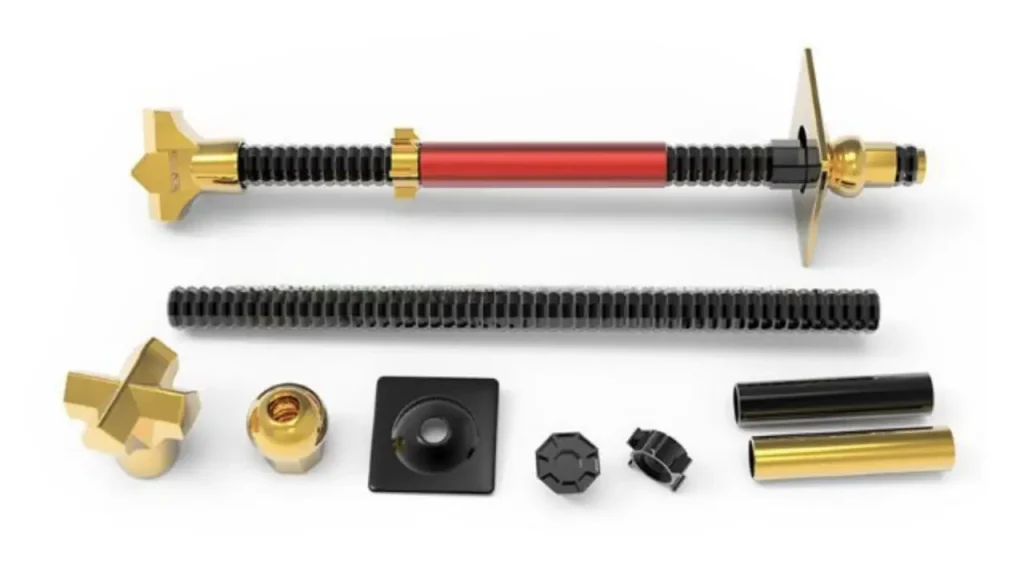
A Self-Drilling Anchor (SDA) system is an advanced geotechnical solution that integrates drilling, grouting, and anchoring into a single, efficient operation.
It utilizes a hollow, threaded bar with a sacrificial drill bit that simultaneously drills into the ground while grout is injected through its core, providing immediate stabilization.
This system is particularly effective in challenging ground conditions like loose soil, fractured rock, or unstable formations where traditional anchoring methods might struggle. SDAs offer faster installation, reduce the need for temporary casing, and provide reliable ground support for various civil engineering and mining applications.
How Does Self-drilling Anchor System Work?
A Self-Drilling Anchor (SDA) system works by integrating the drilling, grouting, and anchoring processes into one seamless operation, significantly enhancing efficiency and speed, particularly in challenging ground conditions.
- Drilling: A hollow, threaded anchor bar, equipped with a sacrificial drill bit at its end, is rotated and driven into the ground using a drilling rig. The hollow core of the bar allows for efficient removal of drilled material.
- Grouting: As the bar advances, cementitious grout is continuously injected under pressure through the hollow core and exits through ports in the drill bit. This grout fills the voids created by the drilling, stabilizing the surrounding ground and ensuring a strong bond between the anchor and the soil or rock.
- Anchoring: Once the desired depth is reached and grouting is complete, the grout solidifies, creating a robust anchor. A bearing plate and nut are then typically installed on the exposed end of the anchor bar to transfer the load from the structure to the anchored ground, providing effective and immediate ground support.
What Does Self-drilling Anchor System Have?
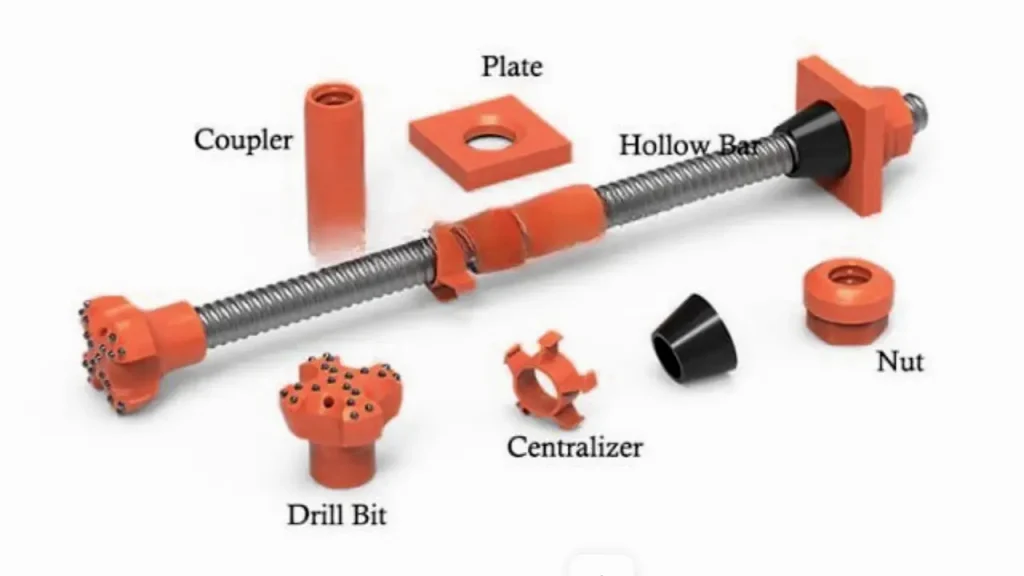
A Self-Drilling Anchor (SDA) system is comprised of several key components that work in unison to provide efficient ground support. These components are designed to withstand various ground conditions and facilitate the integrated drilling and grouting process.
The main elements of a self-drilling anchor system include:
- Hollow Threaded Anchor Bar: This is the core structural element, typically a steel tube with external threading along its entire length. Its hollow core allows for the passage of drilling fluids and grout. These bars come in various types, such as R-thread (ISO 10208) and T-thread (T international standard), suitable for different applications and ground conditions.
- Sacrificial Drill Bit: Attached to the end of the anchor bar, this specialized drill bit is designed to penetrate the ground while allowing grout to flow through its ports. It remains in the borehole after installation.
- Couplers/Extension Couplings: These connect multiple anchor bar sections, allowing for the creation of longer anchors to reach the required depth. They are designed to transmit drilling and percussive energy efficiently.
- Hexagonal Nuts: Made of high-strength steel, these nuts are installed at the exposed end of the anchor bar to apply preload and transfer the anchoring force from the bar to the bearing plate.
- Bearing Plates: These steel plates with a central hole are placed against the ground surface to distribute the load from the anchor bar over a wider area, preventing localized stress and ensuring effective ground support.
- Centralizers (Optional): These devices help maintain the alignment and position of the hollow anchor bar within the borehole, ensuring proper grout coverage and a consistent bond.
Self-drilling Anchor Nuts
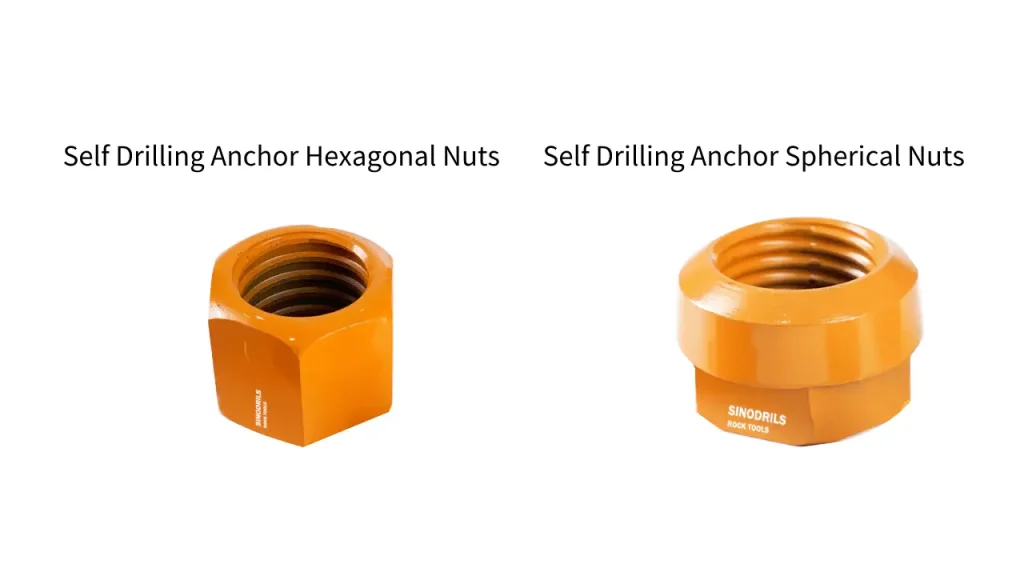
Self-drilling anchor nuts are specialized fastening components used in conjunction with self-drilling anchor bars, which are designed for challenging ground conditions where traditional drilling and grouting methods may be difficult or impossible. These nuts provide a secure connection for the anchor system, ensuring stability and load transfer in various geotechnical and construction applications.
Key characteristics and types include:
Self-Drilling Capability: They are an integral part of a system where the anchor rod itself acts as the drill steel, eliminating the need for a separate drilling operation.
Material: Typically made from high-strength steel to withstand the demanding conditions of ground engineering.
Internal Threading: Designed with internal threading that matches the external threading of the self-drilling anchor bar, allowing for direct connection.
Load Transfer: Crucial for transferring tensile and shear forces from the anchor bar to the bearing plate or other structural elements.
Types:
- Hexagonal Nuts: These are multi-sided nuts (typically six sides) that are tightened with a wrench, providing a strong and common connection. They are designed for straightforward mechanical fastening.
- Spherical Nuts: These nuts feature a spherical or domed seating surface. They are often used in situations where there might be some angular misalignment between the anchor bar and the bearing plate, as the spherical shape allows for a degree of self-alignment, ensuring proper load distribution and reducing stress concentrations.
Types of Self-drilling Anchor System
Self-Drilling Anchor (SDA) systems are primarily categorized by the thread profile of their hollow anchor bars, which dictates their performance characteristics and suitability for different applications. The two main types are R-thread and T-thread systems, each designed to optimize specific aspects of drilling, grouting, and load transfer in various ground conditions.
The common types of self-drilling anchor systems are:
R-thread (Rope Thread) Self-Drilling Anchors: These anchors feature a continuous, wave-like or “rope” thread profile, typically compliant with ISO 10208 and ISO 1720 standards (e.g., R25, R32, R38, R51). R-threads are known for their excellent self-cleaning properties during drilling, making them versatile for a wide range of ground conditions and often used in smaller diameter anchors for general ground support, such as soil nailing and slope stabilization.
T-thread (Trapezoidal Thread) Self-Drilling Anchors: Characterized by a deeper, more robust trapezoidal thread profile, T-threads conform to T International Standards (e.g., T30, T40, T52, T73, T103). This design provides a significantly larger bonding area with the grout, leading to higher bond friction and superior load-bearing capacity. Consequently, T-thread anchors are preferred for applications demanding higher load capacities, such as mini-piles, deep foundations, and heavy structural underpinning in challenging rock and ground conditions.
Self-drilling Anchor System Benefits
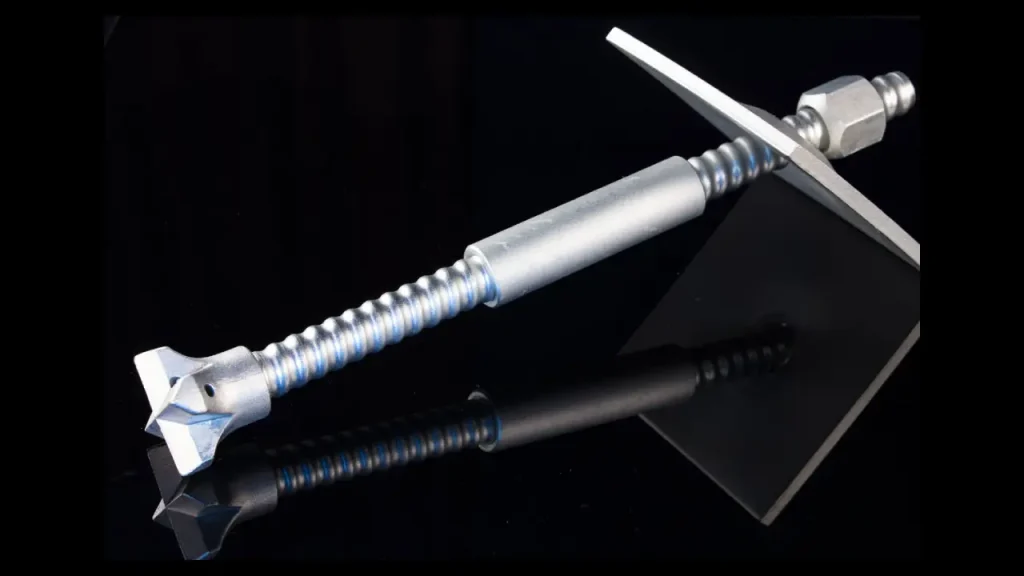
Self-Drilling Anchor (SDA) systems offer a multitude of benefits, making them a preferred choice for various ground engineering applications, especially in challenging conditions. Their integrated drilling and grouting process leads to significant efficiencies and improved project outcomes.
Key benefits of using Self-Drilling Anchor systems include:
- Increased Efficiency and Speed: By combining drilling, grouting, and anchoring into a single operation, SDAs drastically reduce installation time and labor costs compared to traditional multi-step methods. This accelerates project timelines.
- Versatility in Ground Conditions: SDAs are highly adaptable and perform well in a wide range of challenging ground conditions, including loose or collapsing soils, fractured rock, gravel, and unstable formations where open-hole drilling might be difficult or require temporary casing.
- Reduced Equipment and Space Requirements: The integrated nature of the system often means less specialized equipment is needed, and the compact drilling rigs used for SDAs allow for installation in confined or hard-to-access areas.
- Enhanced Ground Stabilization: The simultaneous grouting process fills voids and consolidates the surrounding ground, improving its strength and stability and ensuring a strong bond between the anchor and the soil/rock.
- Cost-Effectiveness: While initial material costs might vary, the overall project cost can be significantly reduced due to faster installation, reduced labor, minimized equipment needs, and elimination of the need for pre-drilling or casing.
- Reliable Performance and Durability: The robust design of the hollow bar and the effective grouting provide high pull-out resistance and long-term stability. Many systems also incorporate corrosion protection for enhanced durability in aggressive environments.
- Minimal Environmental Impact: The streamlined process and smaller footprint of equipment can lead to less disturbance to the surrounding environment.
Self-drilling Anchor System Applications
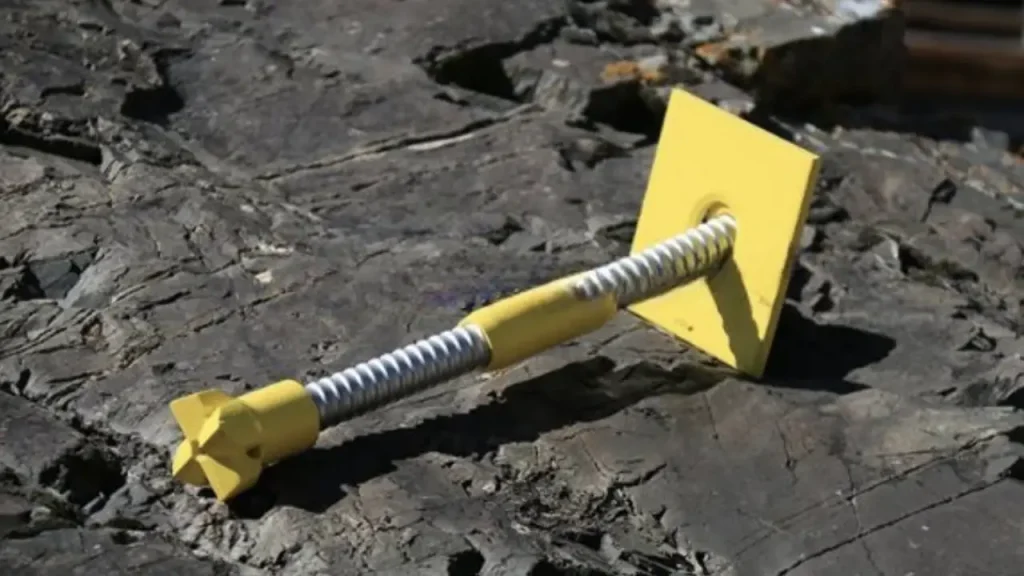
The versatility and efficiency of Self-Drilling Anchor (SDA) systems make them highly suitable for a wide range of geotechnical and civil engineering applications, particularly in challenging or unstable ground conditions.
Their ability to combine drilling, grouting, and anchoring in one operation offers significant advantages in terms of speed, cost-effectiveness, and reliability.
Key applications of Self-Drilling Anchor systems include:
- Radial Bolting: Used in tunneling and mining to provide support around the excavation perimeter, enhancing stability and preventing rockfall.
- Face Stabilization: Essential for securing the excavation face in tunnels and deep cuts, preventing collapses and ensuring worker safety.
- Spiling / Forepoling: A pre-support technique where SDAs are installed ahead of the excavation face to create a reinforced arch, stabilizing unstable ground before tunneling.
- Soil Nailing: A common method for slope stabilization and excavation support, where SDAs reinforce the soil mass, increasing its shear strength.
- Ground Consolidation and Injection: SDAs can be used for injecting grout into loose or permeable ground, improving its strength and reducing permeability.
- Micropile Injection: Employed as small-diameter, high-capacity piles for foundation support, particularly in restricted access areas or where significant uplift capacity is required. Self-Drilling Anchor (SDA) systems are highly versatile and widely used in various geotechnical and civil engineering applications due to their efficiency and adaptability to challenging ground conditions. Their ability to simultaneously drill, grout, and anchor makes them ideal for situations where traditional methods are impractical or too time-consuming.

